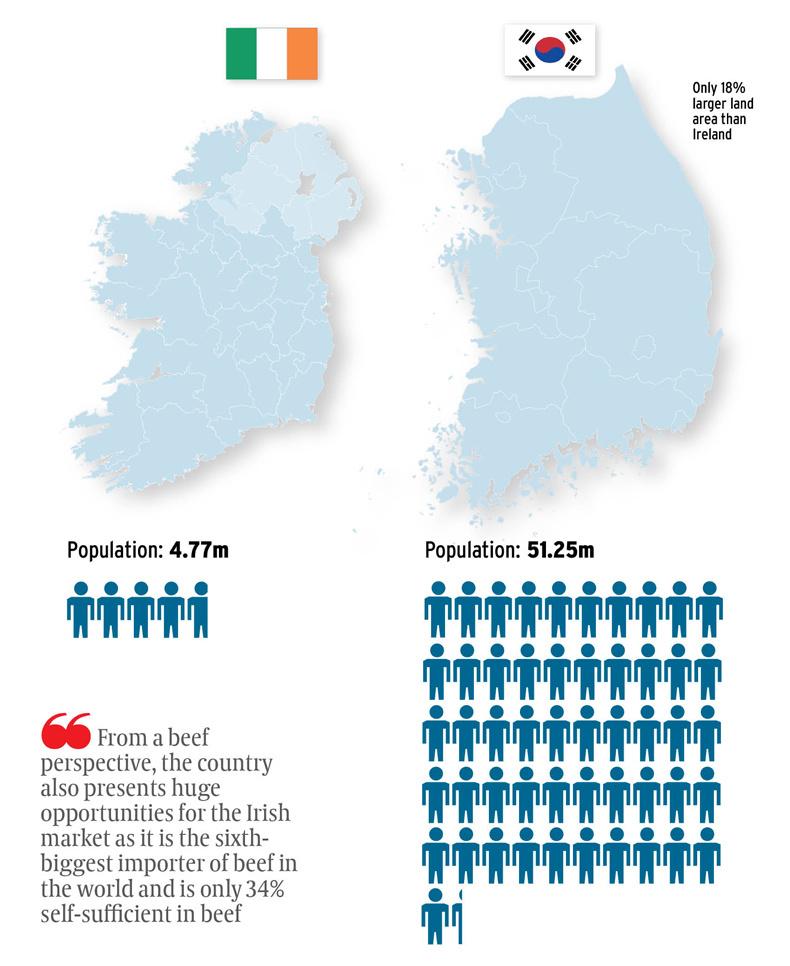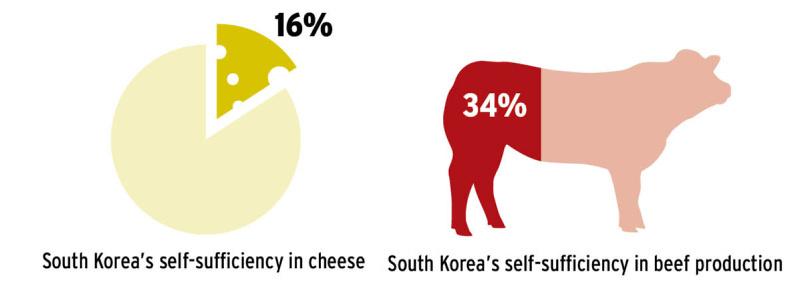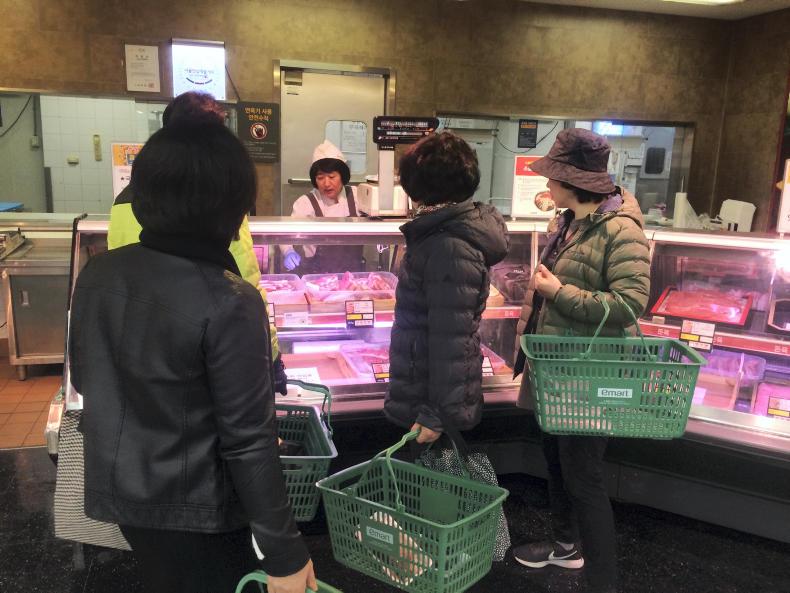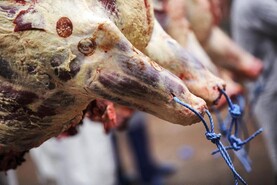Most people can’t think of South Korea without thinking about its aggressive, nuclear-armed, next door neighbour North Korea. The country doesn’t jump off the list of tourist destinations or trading locations, and yet it should.
A number of readers will also be aware of the song by South Korean artist PSY called Gangnam Style
It has a vibrant, modern capital city, Seoul, which is home to the global tech giant Samsung, and a growing middle class with an appreciation for western food, and an obsession with social media and food “selfies”.

A number of readers will also be aware of the song by South Korean artist PSY called Gangnam Style, named after the trendy Gangnam region in Seoul and made famous for the novel dance moves exhibited in the music video.
However, the 30 representatives from the Irish beef and dairy industry who travelled through Gangnam were more interested in business deals than busting a move.

€18bn import market
From a trade point of view, South Korea is just 18% bigger than Ireland but has a population of almost 52m people.
According to the UN, South Korea’s food and drink imports were worth over €18bn in 2016, with the US accounting for the largest share of imports at 25%, followed by China and Australia.
It is the sixth-biggest importer of beef in the world and is only 34% self-sufficient in beef.
Irish trade to South Korea is worth €41m a year, with seafood accounting for 40% of the trade and meat, driven by sales of pigmeat offal, representing 29% of the trade.
Irish dairy products are worth €11m annually and have been driven by a two-fold demand for cheese in the last decade.
This is good news for an Irish dairy industry looking for new cheese markets post-Brexit.
From a beef perspective, the country also presents huge opportunities for the Irish market as it is the sixth-biggest importer of beef in the world and is only 34% self-sufficient in beef.
Market access
However, market access and share remains an issue for both the Irish dairy and beef industry. Although South Korea is only 16% self-sufficient in cheese, the Irish dairy industry will have to go up against New Zealand and the might of the dairy giant Fonterra to carve out a bigger slice of the South Korean market.
On beef, Ireland has yet to gain market access to South Korea
But the increasing demand for cheese and popularity of western food could work to the advantage of the Irish dairy industry in gaining an increased share.
On beef, Ireland has yet to gain market access to South Korea, although we are in the process of gaining approval to trade beef with the country, and have undergone two out of five inspections by South Korean officials.
Minister for Agriculture Michael Creed told the Irish Farmers Journal during the trade mission in Asia that he intended to push the issue of approval.
“We’re outside the door knocking so we have to be polite and respectful of their processes,” Minister Creed said.
“But we’re very confident that we can meet any market requirements. Our product is as good as anything that’s there.”
Beef protest
Bord Bia and the representatives from the Irish beef industry have an advantage over other markets in offering fully traceable beef to the market.
Over 100,000 people flood into the capital city Seoul in protest against American beef.
In a country driven by technology and social media, our guide Kim told the Irish Farmers Journal about a food scare that had rocked the government of South Korea and saw over 100,000 people flood into the capital city Seoul in protest against American beef.
“US beef, they emphasise the taste because of the issue we had in 2008 about mad cow disease,” Kim said.
“It was a very big issue back then so they [the US] do not want to touch that issue. So they do not mention anything now about safety, they just focus on the taste.”
“On the other hand Australia, they emphasise the clean climate, the clean nature and that it’s clean and safe.”
Australian beef represents the highest market share of beef imports to South Korea at 49%, while the US represents the second highest at 43%.
The Australian and US trade titans are more than worthy adversaries, but in an age of social media, with the help of savvy marketing, Irish industries could establish a niche by trading on traceability and traditional farm to fork messages.
Read more
In pictures: what consumers eat in South Korea
Listen: a new trade for Irish cheddar in Japan?
Most people can’t think of South Korea without thinking about its aggressive, nuclear-armed, next door neighbour North Korea. The country doesn’t jump off the list of tourist destinations or trading locations, and yet it should.
A number of readers will also be aware of the song by South Korean artist PSY called Gangnam Style
It has a vibrant, modern capital city, Seoul, which is home to the global tech giant Samsung, and a growing middle class with an appreciation for western food, and an obsession with social media and food “selfies”.

A number of readers will also be aware of the song by South Korean artist PSY called Gangnam Style, named after the trendy Gangnam region in Seoul and made famous for the novel dance moves exhibited in the music video.
However, the 30 representatives from the Irish beef and dairy industry who travelled through Gangnam were more interested in business deals than busting a move.

€18bn import market
From a trade point of view, South Korea is just 18% bigger than Ireland but has a population of almost 52m people.
According to the UN, South Korea’s food and drink imports were worth over €18bn in 2016, with the US accounting for the largest share of imports at 25%, followed by China and Australia.
It is the sixth-biggest importer of beef in the world and is only 34% self-sufficient in beef.
Irish trade to South Korea is worth €41m a year, with seafood accounting for 40% of the trade and meat, driven by sales of pigmeat offal, representing 29% of the trade.
Irish dairy products are worth €11m annually and have been driven by a two-fold demand for cheese in the last decade.
This is good news for an Irish dairy industry looking for new cheese markets post-Brexit.
From a beef perspective, the country also presents huge opportunities for the Irish market as it is the sixth-biggest importer of beef in the world and is only 34% self-sufficient in beef.
Market access
However, market access and share remains an issue for both the Irish dairy and beef industry. Although South Korea is only 16% self-sufficient in cheese, the Irish dairy industry will have to go up against New Zealand and the might of the dairy giant Fonterra to carve out a bigger slice of the South Korean market.
On beef, Ireland has yet to gain market access to South Korea
But the increasing demand for cheese and popularity of western food could work to the advantage of the Irish dairy industry in gaining an increased share.
On beef, Ireland has yet to gain market access to South Korea, although we are in the process of gaining approval to trade beef with the country, and have undergone two out of five inspections by South Korean officials.
Minister for Agriculture Michael Creed told the Irish Farmers Journal during the trade mission in Asia that he intended to push the issue of approval.
“We’re outside the door knocking so we have to be polite and respectful of their processes,” Minister Creed said.
“But we’re very confident that we can meet any market requirements. Our product is as good as anything that’s there.”
Beef protest
Bord Bia and the representatives from the Irish beef industry have an advantage over other markets in offering fully traceable beef to the market.
Over 100,000 people flood into the capital city Seoul in protest against American beef.
In a country driven by technology and social media, our guide Kim told the Irish Farmers Journal about a food scare that had rocked the government of South Korea and saw over 100,000 people flood into the capital city Seoul in protest against American beef.
“US beef, they emphasise the taste because of the issue we had in 2008 about mad cow disease,” Kim said.
“It was a very big issue back then so they [the US] do not want to touch that issue. So they do not mention anything now about safety, they just focus on the taste.”
“On the other hand Australia, they emphasise the clean climate, the clean nature and that it’s clean and safe.”
Australian beef represents the highest market share of beef imports to South Korea at 49%, while the US represents the second highest at 43%.
The Australian and US trade titans are more than worthy adversaries, but in an age of social media, with the help of savvy marketing, Irish industries could establish a niche by trading on traceability and traditional farm to fork messages.
Read more
In pictures: what consumers eat in South Korea
Listen: a new trade for Irish cheddar in Japan?








 This is a subscriber-only article
This is a subscriber-only article













SHARING OPTIONS: